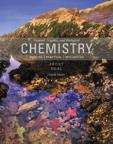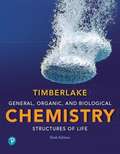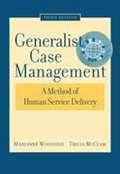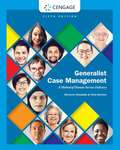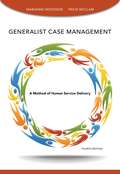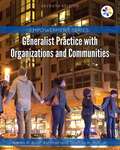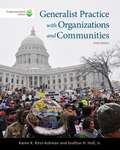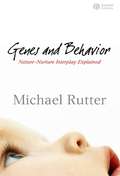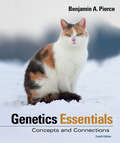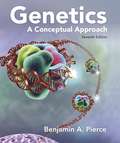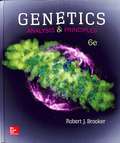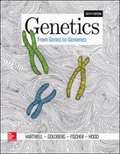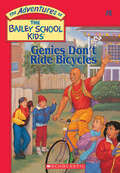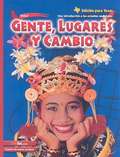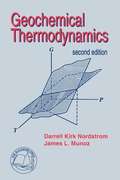- Table View
- List View
General, Organic, And Biological Chemistry
by Karen C. Timberlake Laura D. Frost S. Todd DealFrost and Deal's General, Organic, and Biological Chemistry gives students a focused introduction to the fundamental and relevant connections between chemistry and life. Emphasizing the development of problem-solving skills with distinct Inquiry Questions and Activities, this text empowers students to solve problems in different and applied contexts relating to health and biochemistry. Integrated coverage of biochemical applications throughout keeps students interested in the material and allow for a more efficient progression through the topics. Concise, practical, and integrated, Frost's streamlined approach offers students a clear path through the content. Applications throughout the narrative, the visual program, and problem-solving support in each chapter improve their retention of the concepts and skills as they master them. General, organic, and biological chemistry topics are integrated throughout each chapter to create a seamless framework that immediately relates chemistry to students' future allied health careers and their everyday lives.
General, Organic, and Biochemistry
by McGraw-Hill CreateGeneral, Organic, and Biochemistry Custom Edition
General, Organic, and Biological Chemistry: Structures of Life
by Karen TimberlakeGeneral, Organic, and Biological Chemistry: Structures of Life engages students by helping them see the connections between chemistry, the world around them, and future health-related careers. Known for its friendly writing style, student focus, robust problem-solving pedagogy, and engaging health-related applications, the text prepares students for their careers. The text breaks chemical concepts and problem solving into clear, manageable pieces to ensure students stay on track and motivated throughout their first, and often only, chemistry course. <p><p> With the newly revised 6th Edition, best-selling author Karen Timberlake and new contributing author MaryKay Orgill connect chemistry to real-world and career applications. Their goal is to help students become critical thinkers by understanding scientific concepts that will form a basis for making important decisions about issues concerning health and the environment and their intended careers. <p> The new edition introduces more problem-solving strategies, more problem-solving guides, new Analyze the Problem with Connect features, new Try It First and Engage features, conceptual and challenge problems, and new sets of combined problems—all to help students develop the problem-solving skills they’ll need beyond the classroom.
Generalist Case Management: A Method of Human Service Delivery
by Tricia Mcclam Marianne R. WoodsideGoing beyond traditional definitions of case management, the authors (of the U. of Tennessee) suggest a broader perspective that sees a greater emphasis on its role in service delivery in the human services. In this introduction to case management, they describe the case management process from intake interview to termination; examine professional issues and skills, discuss the history of case management, and describe the models used. They also cover ethical and legal issues and conclude with a chapter on managing a career as a case manager. Annotation ©2005 Book News, Inc., Portland, OR (booknews.com)
Generalist Case Management: A Method of Human Service Delivery
by Marianne Woodside Tricia McClamBecome an effective case manager with GENERALIST CASE MANAGEMENT: A METHOD OF HUMAN SERVICE DELIVERY, 5th Edition. You'll be drawn into the text early on when you meet Sharon Bello, a client involved in the case management process. Realistic and relevant, this text provides you with the fundamental skills and information you need to coordinate and provide services to a variety of populations. Case studies, interviews with human service case managers nationwide, and opportunities to apply what you learn to real-life issues are just a few of the tools that will help you become an effective advocate for your client. You'll also gain practical knowledge to help you prepare for earning C-SWMC certification and the HS-BCP credential.
Generalist Case Management: A Method of Human Service Delivery (Fourth Edition)
by Marianne Woodside Tricia McclamBecome an effective case manager with GENERALIST CASE MANAGEMENT: A METHOD OF HUMAN SERVICE DELIVERY, 4th Edition. Realistic and relevant, this counseling book provides you with the fundamental skills and information you need to coordinate and provide services to a variety of populations. Case studies, interviews with human service case managers nationwide, and opportunities to apply what you learn to real-life issues are just a few of the tools that will help you become an effective advocate for your client.
Generalist Practice with Organizations and Communities
by Karen K. Kirst-Ashman Grafton H. Hull Jr.This book is a guide to generalist social work practice with organizations and communities. The three adjectives that best describe this text are relevant, practical, and readable. Generalist practice is clearly defined, and specific macro-practice skills are presented in a straightforward and interesting manner. Applications to actual macro-practice situations are emphasized throughout, as is the importance of client system strengths. The content is geared to both the undergraduate and graduate generalist practice sequences.
Generalist Practice with Organizations and Communities, Sixth Edition
by Karen K. Kirst-Ashman Grafton H. HullThis book is a guide to generalist social work practice with organizations and communities. The sixth edition is thoroughly updated to reflect the Council on Social Work Education's (CSWE) latest ethical standards as well as contemporary issues in social work literature.
Genes and Behavior: Nature-Nurture Interplay Explained
by Michael RutterIn this major new book, eminent scientist Professor Sir Michael Rutter gets behind the hype of the behavioral genetics debate to provide a balanced and authoritative overview of the genetic revolution and its implications for understanding human behavior. Written by one of the world's leading figures in child psychology and psychiatry, Professor Sir Michael Rutter Provides non-technical explanation of genetics to diffuse the sensational debates surrounding the topic Sets out in layman's terms what genes do, how much is nature and how much is nurture Argues that nature and nurture are not truly separate and gives examples of how the two interact Looks at the implications of genetic findings for policy and practice The book will inform public debate about the implications of the Human Genome Project and, more broadly, the field of genetic science.
Genetics Essentials: Concepts And Connections
by Benjamin A. PierceDerived from his popular and acclaimed Genetics: A Conceptual Approach, Ben Pierce’s streamlined text covers basic transmission, molecular, and population genetics in just 18 chapters, helping students uncover major concepts of genetics and make connections among those concepts as a way of gaining a richer understanding of the essentials of genetics. <p> With the new edition, Ben Pierce again focuses on the most pervasive problems for students taking genetics—understanding how genetics concepts connect to each other and developing solid problem solving skills. There is updated coverage of important research developments in genetics (CRISPR) and a new Active Learning feature, Think, Pair, Share. And with this edition, Genetics Essentials is available as a fully integrated text/media resource with SaplingPlus, an online solution that combines an e-book of the text, Pierce’s powerful multimedia resources, and Sapling’s robust genetics problem library.
Genetics: A Conceptual Approach
by Benjamin A. PierceBen Pierce brings a master teacher’s experiences to the introductory genetics textbook, clarifying this complex subject by focusing on the big picture of genetics concepts and how those concepts connect to one another. New question types, more learning guidelines for students, and an updated art program round out a powerful text, and improvements to the online resources in SaplingPlus give students the conceptual and problem solving understanding they need for success.
Genetics: Analysis And Principles
by Robert J. BrookerIn the sixth edition of Genetics: Analysis & Principles, the content has been updated to reflect current trends in the field. In addition, the presentation of the content has been improved in a way that fosters active learning. As an author, researcher, and teacher, I want a textbook that gets students actively involved in learning genetics. To achieve this goal, I have worked with a talented team of editors, illustrators, and media specialists who have helped me to make the sixth edition of Genetics: Analysis & Principles a fun learning tool. <p><p> Overall, an effective textbook needs to accomplish four goals. First, it needs to provide comprehensive, accurate, and up-to-date content in its field. Second, it needs to expose students to the techniques and skills they will need to become successful in that field. Third, an effective textbook should have pedagogical features, such as formative assessment, that foster student learn¬ing. And finally, it should inspire students so they want to pursue that field as a career. The hard work that has gone into the sixth edition of Genetics: Analysis & Principles has been aimed at achieving all four of these goals!
Genetics: Analysis of Genes and Genomes (6th Edition)
by Daniel L. Hartl Elizabeth W. JonesThis introductory college level textbook introduces the basic processes of gene transmission, mutation, expression, and regulation. Hartl (Harvard U. ) and Jones (Carnegie Mellon U. ) present an integrated view of the modern world of genetics, treating classical, molecular, and population genetics as unified subdisciplines within the field. Modern an
Genetics: From Genes to Genomes
by Janice Fischer HartwellGenetics : from genes to genomes represents a new approach to an undergraduate course in genetics. It reflects the way we, the authors, currently view the molecular basis of life. We integrate: formal genetics: the rules by which genes are transmitted. Molecular genetics: the structure of DNA and how it directs the structure of proteins. Digital analysis and genomics: recent technologies that allow a comprehensive analysis of the entire gene set and its expression in an organism. Human genetics: how genes contribute to health and diseases, including cancer. The unity of life-forms: the synthesis of information from many different organisms into coherent models. Molecular evolution: the molecular mechanisms by which biological systems, whole organisms, and populations have evolved and diverged.
Genies Don't Ride Bicycles (Adventures of the Bailey School Kids)
by Debbie Dadey Marcia Thornton JonesThe hugely popular early chapter book series re-emerges -- now in e-book! Ever since Eugene became their new neighbor, the third graders at Bailey Elementary School get everything they wish for. This all seems great . . . until their lives start to turn upside down.
Genocide: A Comprehensive Introduction
by Adam JonesGenocide: A Comprehensive Introduction is the most wide-ranging textbook on genocide yet published. The book is designed as a text for upper-undergraduate and graduate students, as well as a primer for non-specialists and general readers interested in learning about one of humanity's enduring blights. Fully updated to reflect the latest thinking in this rapidly developing field, this new edition: provides an introduction to genocide as both a historical phenomenon and an analytical-legal concept, including an extended discussion of the concept of genocidal intent, and the dynamism and contingency of genocidal processes discusses the role of state-building, imperialism, war, and social revolution in fueling genocide supplies a wide range of full-length case studies of genocides worldwide, each with an accompanying box-text explores perspectives on genocide from the social sciences, including psychology, sociology, anthropology, political science/international relations, and gender studies considers "The Future of Genocide," with attention to historical memory and genocide denial; initiatives for truth, justice, and redress; and strategies of intervention and prevention. Written in clear and lively prose, liberally sprinkled with over 100 illustrations and maps, and including personal testimonies from genocide survivors,Genocide: A Comprehensive Introductionhas established itself as the core textbook of the new generation of genocide scholarship. An accompanying website (www. genocidetext. net) features a broad selection of supplementary materials, teaching aids, and Internet resources.
Gente del bosque, gente del desierto (¡Arriba la Lectura!, Level N #84)
by Jaqueline GreeneNIMAC-sourced textbook. Descubre cómo hace unos 400 años los indígenas americanos vivieron en el bosque y el desierto. Con sus hogares, su vestimenta y sus alimentos sobrevivieron los difíciles inviernos de los Grandes Lagos y los veranos secos del Suroeste.
Gente y Lugares (Grade 1, Edicion para Texas)
by James A. Banks Kevin P. Colleary Walter C. Parker Gloria Contreras Mary A. Mcfarland A. Lin Goodwin Richard BoehmA Spanish textbook that teaches about culture, history, people and places.
Gente, Lugares y Cambio: Una Introduccion a los Estudios Mundiales
by Robert J. Sager David M. Helgren Alison S. BrooksSpanish version of "People, Places and Change," a social studies textbook about world culture.
Gentle Giants of the Sea (Fountas & Pinnell Classroom, Guided Reading)
by Kitty ColtonNIMAC-sourced textbook
Geochemical Thermodynamics
by Darrell Kirk Nordstron James L. MunozGeochemical Thermodynamics (Second Edition), first published in 1994, takes the reader beyond the fundamental principles of thermodynamics to true geochemical applications. You will find the most complete coverage of the phase rule, chemography, solid solutions, ionic activities in the mixed aqueous electrolytes, and chemical potential diagrams for multiphase systems, plus other concepts central to geochemical theory. Throughout, there is an emphasis on environmentally relevant examples and applications. New sections include: - thermobarometry applications for igneous and metamorphic rocks; -expanding information on electrolytes at high temperature and pressure; - a new chapter on geochemical modeling; and substantially updated and expanded references. - a new appendix containing internally consistent enthalpies, entropies, heat capacities, and free energies, and equilibrium constants for a limited number of elements, ions, non-silicate minerals, and reactions at 298. 15K and 1 atmosphere that are particularly useful for hydrogeochemical modeling. 'This book presents the thermodynamics of geochemical systems, with applications ranging from groundwater to magmas. It should be of interest to a large number of such scientists wishing better acquaintance with the application of thermodynamics to practical problems. Geology There is a good balance of theory and application, and the book is superior to any other available text at the graduate or undergraduate level I can strongly recommend this book, having used it for a third-year undergraduate geochemistry course. It is most appropriate for physical geochemistry course with an emphases on thermodynamics. Researchers in petrology oriented fields will also find the book useful Canadian Mineralogist
Geography
by Arthur Getis Judith M. GetisGeography introduces students to the scope and excitement of geography and its relevance to their daily lives. This edition continues to convey the breadth of geography and to provide insight into the nature and intellectual challenges of the field of geography itself.
